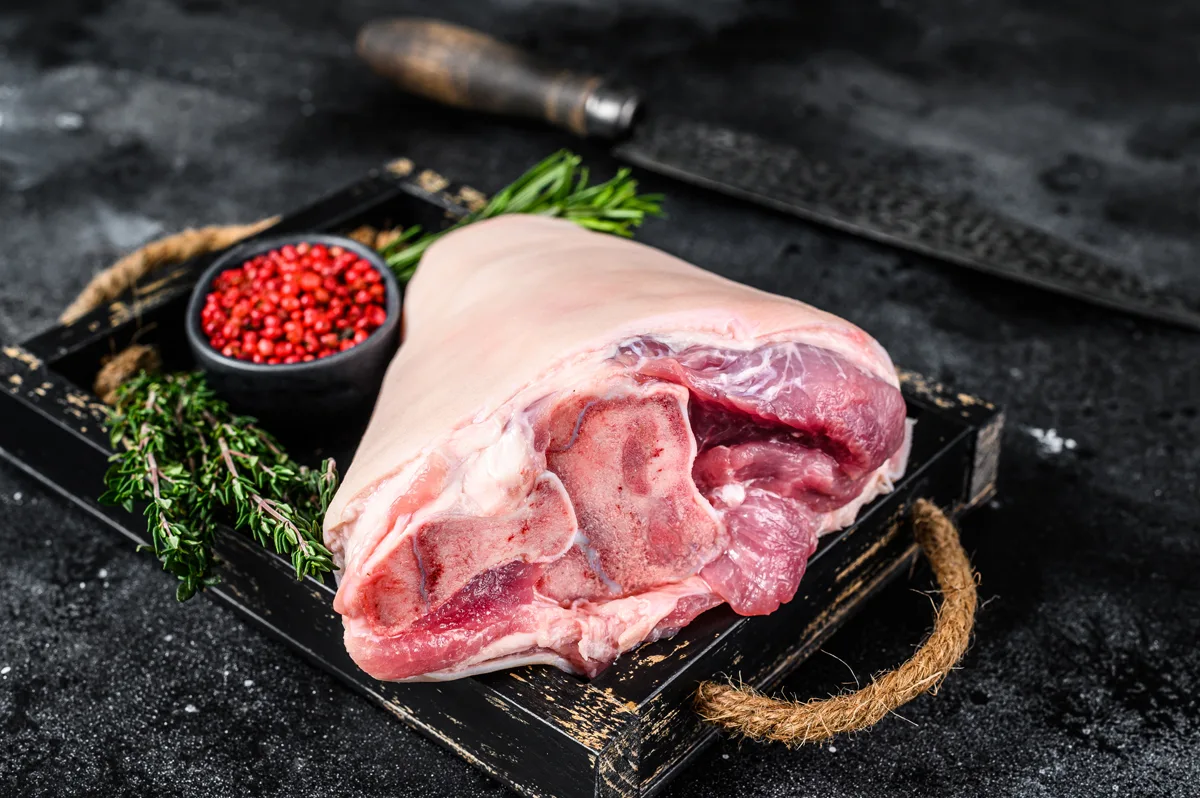Ham hocks are the perfect meat for seasoning food. Rarely are ham hocks served as a stand-alone dish.
They are so flavorful that they are the perfect addition to vegetable dishes such as collard greens.
Although ham hocks are very popular, most people overlook one of the most important aspects of ham hocks: where it comes from on the pig.
The average person may not care where ham hocks come from. Their only concern is that the ham hock infuses their food with a smoky, salty flavor.
However, knowing where the ham hock comes from on the hog is very important. It will truly help you have the best ham hock experience.
Contents
Are Ham Hocks Bad for You?
Whether ham hocks are healthy depends on how you look at it. On the one hand, ham hocks contain a healthy amount of protein.
Protein consists of amino acids that help produce and repair muscles and bones and produce hormones and enzymes.
On the other hand, ham hocks contain high levels of sodium, especially the smoked variety.
A 4 oz. serving of ham hocks have 115 milligrams of sodium which is about 7.6% of the daily recommended amount of sodium.
Therefore, you should consume ham hocks in moderation.
Are Ham Hocks the Pig’s Ankle?
Most people assume the ham hock is the ankle of the pig because its location is equivalent to where a human ankle would be. However, this isn’t exactly true.
Ham hocks consist of the joint that joins the pig’s trotter to the leg.
So it’s not exactly the pig’s leg or trotter, but the ham hock is the space in between.
Are Pork Hocks the Same Thing as Ham Hocks?
People also assume ham hocks and pork hocks are the same. Ham hocks and pork hocks are not the same cut of pork.
However, pork hocks come from the front legs. In contrast, ham hocks come from the pig’s rear legs.
What Part of the Pig Is the Ham Hock?
So, if a ham hock is not a pig ankle or a pork hock, what exactly are ham hocks? More importantly, where do ham hocks come from?
Ham hocks are fabricated from the lower portion of the animal’s back legs. Ham hocks are chunky hunks of bone that are about 4 inches in length.
The bone is encased in a mixture of collagen, meat, and connective tissue, which is surrounded by a thick cap of fat as well as skin.
Ham hocks are usually salt-cured and smoked, giving them a bacon-like flavor that enhances any dish you add them to.
There are a few pre-weighed ham hocks in each package. Furthermore, ham hocks are relatively inexpensive and cost less than $5 a pound.
What Can I Use in Place of a Ham Hock?
The best substitutes for ham hocks are smoked bacon, smoked ham, or smoked pork shank.
Although they are much meatier than ham hicks, they have a similar flavor since ham hocks are almost always smoked.
How To Cook Ham Hocks
There are multiple ways to cook ham hocks.
Ham hocks are not meaty like bacon, so they are best added when added to dishes that are cooked low and slow such as beans or collard greens.
This is the only way will the ham hocks will become tender and delicious.
Essentially, when ham hocks are braised in a liquid for a long time, the collagen and fat within the meat slowly render, releasing the salty, smoky flavor into the other ingredients in the dish.
You can remove the fat from the ham hock, remove the meat, and stir it back into the dish.
If you are cooking ham hocks on their own, it’s best to add them to the slow cooker for 4-8 hours until it is tender.
You can stir it into other dishes or use it as a salad.
You can also marinate or brine the ham hocks to tenderize the meat.
You can also boil ham hocks until they become tender, then sear them in a cast-iron skillet until it gets crispy, golden brown, and delicious.
Final Thoughts
Ham hocks are the quintessential ingredients of many foods.
However, most people will focus on ham hocks taste, but knowing where it comes from gives you a different appreciation for ham hocks.
Now you can add home hocks to your salads, soups, or greens and share the knowledge you just learned with your loved ones.
You might also be interested in the following:
- What Part of the Pig Is Chorizo
- What Part of the Pig Is Pork Chops
- What Part of the Pig Is Ham
- What Part of the Pig Is Bacon

I have been smoking and grilling meat from an early age and enjoy sharing my knowledge and expertise through the hundreds of articles I have written about BBQ. I hope to make everyone’s BBQ journey that little bit easier.

